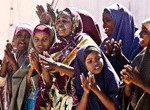Somalia will not meet most, if any, of the MDGs
Published on Thu, 2013-05-30 13:12
Despite the vision of the Somali Reconstruction and Development Programme (RDP), a pro-poor instrument and support from the international community, Somalia is unlikely to meet most, if any, of the Millennium Development Goals (MDGs) by 2015. Almost 66% of the population is living in severe poverty. Together with the rest of Horn of Africa, Somalia is now recovering from the worst famine in 60 years, affecting over one-third of its population, armed conflict continues in many areas of the country and the international aid system is unable to meet basic needs: 3.8 million are still in need of emergency aid. With the election of a reform-minded president and speaker of parliament at the end of 2012, will the country be able to overcome these challenges and improve people’s livelihoods? At a time when major breakthroughs were taking place in the field of development, including the release of first Human Development Report in 1990, Somalia was in its death throes. Moreover, the two decades of armed conflict that followed the state collapse in 1991 have taken a heavy toll on people, institutions, the economy and the environment. Nevertheless, the first post-civil war administration, the four-year old Transitional National Government of Somalia (TNG) was among the states that participated in drawing up the Millennium Declaration in 2000. The formation of Transitional Federal Institutions in Somalia in 2004 was seen as a critical opportunity to “achieve peace and security, promote governance and the rule of law, begin recovery, reconstruction and development, reverse regression from the Millennium Development Goals (MDGs), and advance sustainable socio-economic development throughout Somalia.” In 2005, responding to the request of the Transitional Federal Government (TFG) and the international community, the United Nations Development Group and the World Bank co-directed a Post Conflict Needs Assessment (PCNA), the first and the largest of its kind in Somalia. The main objective of the Somali Joint Needs Assessment (JNA) was “to assess needs and develop a prioritized set of reconstruction and development initiatives to support Somali-led efforts to deepen peace and reduce poverty,” a process that finally produced the Somali Reconstruction and Development Programme (RDP), a pro-poor instrument, strategy and a framework for recovery and development interventions. However, progress reports produced since 2007 by UNDP Somalia and the TFG have indicated that the country is lagging far behind track to meet most, if not all, of Millennium Development Goals (MDGs) by 2015. Oxford’s Multidimensional Poverty Index (MPI) reported from a 2006 survey that 65.6% of the population lives in severe poverty, lacking basic services, including access to education. Moreover, the Fund for Peace report in 2012 indicated that appalling as it was in the past, the situation is growing worse. Together with the rest of Horn of Africa, Somalia is now recovering from the worst famine in 60 years hit over one-third of its population, and the politicized aid system is unable to meet basic needs. Some 3.8 million people in Somalia are still in need of emergency aid. Source: National report from Somalia, Social Watch Report 2013. |
SUSCRIBE TO OUR NEWSLETTER



